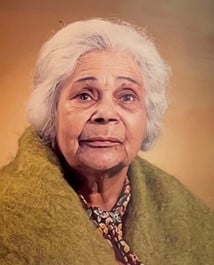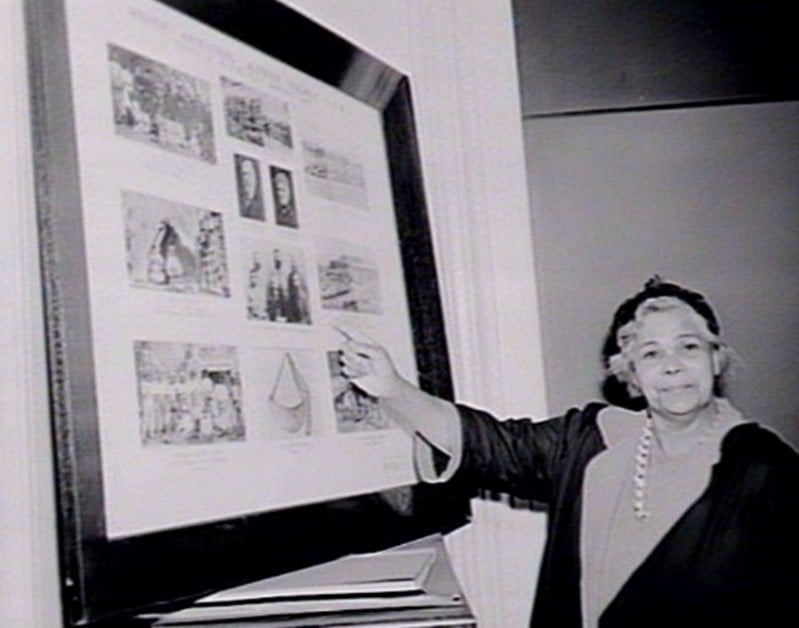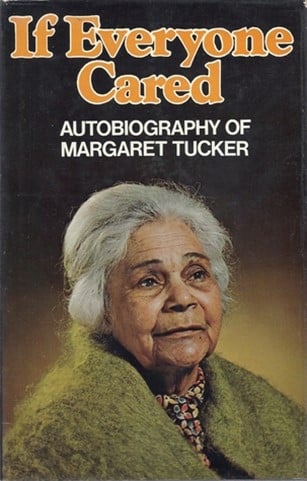Born Lilardia (meaning ‘flower’), Auntie Marge Tucker grew up on Moonahculla Inland Mission Settlement, one of four sisters. On her mother’s side her family were Yorta Yorta people and on her father’s side, Wiradjuri.1
After a childhood spent by the Murrumbidgee River, at 13 Auntie Marge was cruelly separated from her mother and sent to Cootamundra Domestic Training Home for Girls. In her autobiography she recalls the anguish on her mother’s face as her daughter was taken away by police.2 Following her time at Cootamundra Auntie Marge worked as a domestic servant in New South Wales before gaining her freedom and moving to inner city Melbourne.

H 2019.87/4, State Library Victoria. This work is in copyright.
She was not the sort of person to stand idle and wanted more for her community and her people. In 1932 Auntie Marge became a founding member and treasurer of the Australian Aborigines League and later a prominent member of the Aborigines Advancement League. She was among a group who represented the Victorian Aboriginal community at the Day of Mourning in Sydney in 1938.3 This began her lifetime of activism and campaigning for Aboriginal rights. She was also a frequent speaker at The Domain in Melbourne. Auntie Marge became involved with the Federal Council for the Advancement of Aboriginal and Torres Strait Islanders (FCAATSI) who were a powerful force in the 1967 referendum campaign. During the 1960s she also founded the Victorian Council of Aboriginal and Islander Women along with her sister, Geraldine Briggs who was an active member of FCAATSI and had been involved in the walk off at Cummergunga in 1939.4 Together their efforts helped to establish the first national body for Indigenous Australian women, the National Council of Aboriginal and Islander Women. Auntie Marge later joined the Moral Rearmament movement and travelled to America where she represented Australia’s Aboriginal and Torres Strait Islander peoples at an international conference held in Mackinac Island.

Government Printing Office 2 – 21654,
State Library of New South Wales
Among her many achievements Auntie Marge also organised social nights for Aboriginal women in domestic service as well as the first Aboriginal Debutante Ball in 1949.5
The history of Aboriginal debutante balls is explored by Nakkiah Lui and Miranda Tapsell in their podcast, Debutante: Race, Resistance and Girl Power. The debutante balls, which sprang from Auntie Marge’s original idea, gave a sense of pride and respect to young Aboriginal girls for many generations.
Auntie Marge Tucker’s autobiography If Everyone Cared was published in 1977 and details her early life as well as her struggles for the rights of Aboriginal peoples. A collection of photographs that accompany her autobiography are kept here at State Library Victoria. Auntie Marge was awarded an MBE in 1968.

Auntie Marge (Margaret) Tucker died in 1996 survived by her daughter, Mollie Burns and her family. Her legacy today as a changemaker is one of campaigning for Aboriginal rights, telling Aboriginal stories and giving hope to new generations of Aboriginal women.
- First People’s State relations, Victorian Government, Margaret Tucker MBE(C), viewed 29 April 2022, https://www.firstpeoplesrelations.vic.gov.au/margaret-tucker-mbec
- Tucker, M (1983) If Everyone Cared, Grosvenor Books, South Melbourne
- Obituaries Australia, National Centre of Biography, Australian National University, John Farquharson, Tucker, Margaret Elizabeth (Auntie Marge) (1904–1996), viewed 29 April 2022, https://ia.anu.edu.au/biography/tucker-margaret-elizabeth-auntie-marge-1556/text1618
- National Museum of Australia, Geraldine Briggs, viewed 29 April 2022, https://www.nma.gov.au/explore/features/indigenous-rights/people/geraldine-briggs
- First People’s State relations, Victorian Government, Margaret Tucker MBE(C), viewed 29 April 2022, https://www.firstpeoplesrelations.vic.gov.au/margaret-tucker-mbec

